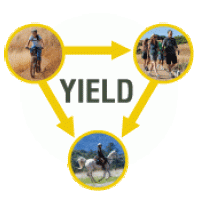The largest of the open space lands that Midpen manages, Sierra Azul Preserve protects more than 19,000 acres of wilderness in the Santa Cruz Mountains. Overlooking the Lexington Reservoir, Los Gatos and southern neighborhoods of San Jose, the preserve encompasses much of the Sierra Azul range and its foothills - topped by the 3,486-foot peak of Mount Umunhum. With 26 miles of multiuse trails for hiking, dog walking, biking and horseback riding, the varied landscape offers visitors views of serpentine grasslands, rocky and steep chaparral, dense stands of bay trees, shaded oak woodland forests, deep ravines and riparian corridors that surround the seasonal or year-round water flow. Prime mountain lion habitat, Sierra Azul Preserve also provides homes for deer, bobcats, coyotes and many other species of animals.
This preserve has the beauty and ruggedness of an unspoiled wilderness, but has been inhabited by people for a millennia. Native Americans have celebrated their traditions and histories at Mount Umunhum, which figures prominently in the Amah Mutsun people's creation story. German and Austrian refugees of the Franco-Prussian War settled in the area in 1870 to be near the New Almaden Quicksilver mining operations, developing the land for orchards and vineyards. From 1957 to 1980, the Mount Umunhum summit was the site of the Almaden Air Force Station, which served as part of a network of radar stations. The square concrete structure that is still visible was once the base for a large Cold War-era radar sail.
Due to its size, Sierra Azul Preserve is divided into four areas. Two are open to the public: Kennedy-Limekiln and Mount Umunhum, which opened in 2017 after a nearly decade-long effort to remove many of the abandoned military buildings, clean up the site's hazardous materials and restore the summit. Cathedral Oaks and Rancho de Guadalupe Areas are closed, but opening them to public access are priority projects of the Measure AA general obligation bond.









































